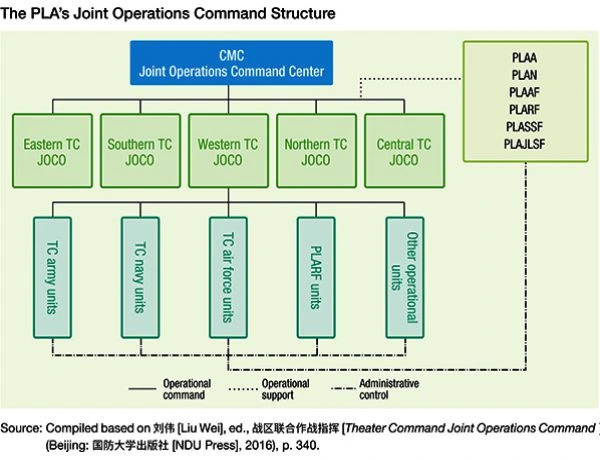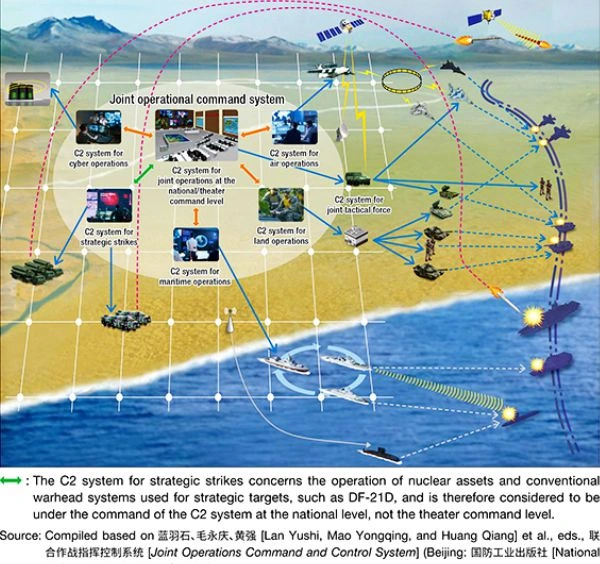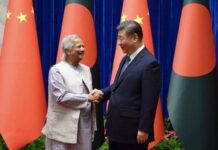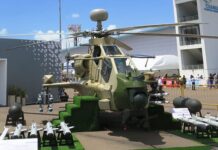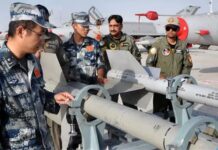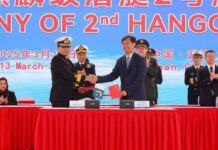Key Takeaways
• The PLA is aggressively developing capabilities to provide options for the PRC to dissuade, deter, or, if ordered, defeat third-party intervention in the Asia-Pacific region.
• The PLA is also developing the capabilities to conduct military operations deeper into the Indo-Pacific region, and in some cases, globally.
• Although the PLA has undertaken important structural reforms to promote joint operations, the capability of the PLA to carry out joint operations in support of counter-intervention or joint campaigns outside the First Island Chain remains in its infancy.
Joint Capabilities for Counter-intervention
The PRC’s counter-intervention strategy aims to restrict the United States from having a presence in China’s immediate periphery and limit US access in the broader Asia-Pacific region. The PLA’s anti-access/area-denial (A2/AD) capabilities are, to date, the most robust within the First Island Chain, although the PLA is increasingly able to project power into the Philippine Sea, and the PRC seeks to strengthen its capabilities to reach farther into the Pacific Ocean.
PLA ground, naval, air and rocket forces are increasingly capable of projecting power at greater distances from China. However, joint service training is still in its infancy and the PLA has demonstrated limited joint operational capabilities beyond the FIC. Instead, overseas activities are mostly conducted by single services and do not involve combat.
Beijing recognizes the importance of increasing military capabilities to achieve global security objectives and has encouraged the PLA to increase its operations beyond the Indo- Pacific. As detailed in China’s 2015 and 2019 Defense White Papers, Beijing is primarily interested in developing these capabilities to protect Chinese maritime rights and commercial interests. However, the majority of PLA modernization and recent exercises remains focused on fighting and winning a regional conflict. As Beijing’s economic interests expand in areas like Africa, Latin America, Central Asia, and the Middle East, we expect to see increased focus on expanding power projection operations globally.
Long-Range Precision Strike and Supporting ISR. PLA doctrinal writings state that precision attack in all warfare domains is critical in modern war. The PLA further notes that small elite forces using advanced weapons or capabilities can attain military effects that previously required large armies and much higher levels of damage and cost. Therefore, PLA writings state that precision weapons are not only force multipliers, but also a means of “war control” to prevent escalation. PLA documents further state that the range of vital political, economic, and military targets has grown as the advanced globalized economy develops, implying that growing PLA strike capabilities will attack an increasing array of targets, and thereby attaining international strategic effects by striking critical nodes of the global economy during a future conflict. The PRC’s military modernization efforts have rapidly transformed the PLA’s missile force. PLA writings frame logistics and power projection assets as potential vulnerabilities in modern warfare, which aligns with the PLA’s expanding ability to conduct strikes against regional air bases, logistics and port facilities, communications, and other ground-based infrastructure.
U.S. bases in Guam are in range of a growing number of the PLA’s ballistic and cruise missiles. In the future, LACMs will also likely be deployable on surface platforms like the RENHAI class guided-missile cruisers. H-6K bomber flights into the Philippine Sea demonstrate the PRC’s ability to range Guam with air-launched LACMs. The DF-26 intermediate range ballistic missile is capable of reaching Guam, and is capable of conducting nuclear, precision conventional, and maritime attacks.
China views its ability to acquire timely, high-fidelity information as critical to its ability to execute precision strikes. The PLA’s information support system for precision strikes depends heavily on Strategic Support Force (SSF) assets to detect, identify, target, and conduct battlefield damage assessments. China emphasizes the importance of space-based surveillance capabilities in supporting precision strikes. In 2021, the PRC continued to develop its constellation of military reconnaissance satellites that could support monitoring, tracking, and targeting of U.S. and allied forces, while also investing in reconnaissance, surveillance, command, control, and communications systems at the strategic, operational, and tactical levels to provide high-fidelity OTH targeting information for its strike platforms.
Integrated Air Defense System (IADS). The PRC has a robust and redundant IADS architecture over land areas and within 300 nm (556 km) of its coast that relies on an extensive early warning radar network, fighter aircraft, and a variety of SAM systems. The PRC has also placed radars and air defense weapons on outposts in the South China Sea, further extending the range of its IADS. It also employs point defenses, primarily to defend strategic targets against adversary long-range cruise missiles and airborne strike platforms.
The PLA has increasing numbers of advanced long-range SAMs, including its indigenous CSA-9 (HQ-9) and its follow-on HQ-9B, Russian SA-10 (S-300PMU), and SA-20 (S- 300PMU1 / PMU2), all of which have the advertised capability to protect against both aircraft and low-flying cruise missiles. To improve its strategic air defenses, the PLA possesses Russian-built SA-21 (S-400) Triumf SAM systems as a follow-on to the SA-20. Compared to these other systems, the SA-21 systems possess a longer maximum range, improved missile seekers, and more sophisticated radars.
The PRC manufactures a variety of long-range air surveillance radars, including models claiming to support ballistic missile defense (BMD) and other models asserting the ability to detect stealth aircraft. Marketing materials also emphasize these systems’ ability to counter long-range airborne strike and combat support aircraft. PLAAF AEW&C aircraft such as the KJ-2000 and KJ-500 can further extend the PRC’s s radar coverage well past the range of its ground-based radars.
Ballistic and Cruise Missile Defense. The PLA’s long-range SAM inventory also offers a limited capability against ballistic missiles. The PRC’s domestic CSA-9 (HQ-9) long-range SAM system likely has a limited capability to provide point defense against tactical ballistic missiles. The PLA has SA-20 (S-300 PMU2) SAMs and SA-21 (S-400) SAMs that may have some capability to engage ballistic missiles, depending on the interceptors and supporting infrastructure. The PRC is working to develop BMD systems consisting of exo-atmospheric and endo-atmospheric kinetic-energy interceptors. China is pursuing a mid-course interceptor that may have capabilities against IRBMs and possibly ICBMs. The RENHAI cruiser has been identified as a platform for mid-course intercept capabilities suggesting the PRC will have forward deployed missile defense in the near future. Additionally, the HQ-19 interceptor has undergone tests to verify its capability against 3,000 km-class ballistic missiles. The PLA’s cruise missile defense capability is more robust than that of its ballistic missile defenses, with short-to-medium range SAMs, such as the HQ-22, augmenting the PLA’s long-range SAMs in this role.
Hypersonic Weapons. China’s deployment of the DF-17 HGV-armed MRBM will continue to transform the PLA’s missile force. The system, fielded in 2020, is possibly intended to replace some older SRBM units, according to PRC media, and is intended to strike foreign military bases and fleets in the Western Pacific, according to a PRC-based military expert.
Aviation Forces (PLAAF, PLAA Aviation, PLAN Aviation). PLA aviation forces are fielding advanced platforms capable of supporting future long-distance operations, as their mission sets evolve from defending Chinese territorial space to launching offensive operations at distances beyond the First Island Chain. While interoperability is a stated priority, joint exercises between the aviation’s forces are limited. Individually, the PLAAF, PLAN Aviation, and PLAA Aviation continue to improve their capabilities to conduct offensive and defensive operations offshore, including strike, air and missile defense, strategic mobility, early warning and reconnaissance missions, and insertion. The PLAAF, in particular, has received repeated calls from its leadership to become a truly “strategic” air force, able to project power at long distances to advance and defend the PRC’s global interests.
• In 2021, the Y-20U tanker entered service, supporting the continued PLAAF expansion of air refuelable fighters, bombers, and SMA aircraft like the KJ-500 AEW&C aircraft. These new air refuelable aircraft will significantly expand China’s ability to conduct long-range offensive air operations.
• China was developing a new generation of long-range bombers, likely named the H- 20, according to multiple reports and a 2016 public statement by then PLAAF Commander General Ma Xiaotian. The H-20, which may debut sometime in the next decade, will have a range of more than 10,000km, enabling the PLAAF to cover the Second Island Chain and into the western region of the Pacific. The H-20 bomber’s range could be extended to cover the globe with aerial refueling. It is also expected to employ both conventional and nuclear weaponry and feature a stealthy design.
• The PLA Army aviation and air assault units are enabling highly-mobile, modular ground task force capable of expeditionary operations. In 2021, the PLAA added at least six heavy lift Z-8 transport helicopters and 12 medium lift Z-20 helicopters. According to PRC media, three Z-8 transport aircraft battalions could airdrop a combat battalion in one lift. The Z-20 is also expected to fill a variety of missions including special force insertion and shipborne ASW.
• PRC’s outposts in the South China Sea extends the operating reach of PLA aviation forces.
Based on the Annual Report by Secretary of Defense to U.S. Congress: Military and Security Developments Involving the People’s Republic of China


